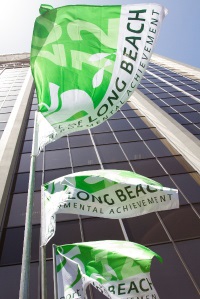Long Beach Hails Success of Slow Down Program

Shipping lines calling at the Port of Long Beach in the U.S. cut thousands of tons of air pollution last year by voluntarily participating in the port’s Green Flag Program. The program offers financial rewards for ships that reduce their speed near the harbor to decrease air emissions of SOx and NOx.
 The program, initiated 11 years ago as part of Long Beach’s Green Port Policy, gives shipping lines a Green Flag to celebrate their environmental accomplishments and dockage rate breaks for slowing to 12 knots or less within 20 or 40 nautical miles of the port.
The program, initiated 11 years ago as part of Long Beach’s Green Port Policy, gives shipping lines a Green Flag to celebrate their environmental accomplishments and dockage rate breaks for slowing to 12 knots or less within 20 or 40 nautical miles of the port.
In 2015, 154 vessel operators met or exceeded the program’s required 90 percent participation rate at either 20 or 40 nautical miles.
The Green Flag Program has been highly successful in reducing air pollution from ships, the leading port-related source of emissions. Since 2005, the port has targeted emissions from ships, trucks, trains, harbor craft and yard equipment. As a result, diesel particulates are down 85 percent, smog-forming sulfur oxides are down 97 percent, nitrogen oxides are down 50 percent and greenhouse gases are down 21 percent.
The Green Port Policy also includes other programs aimed at reducing vessel emissions, including the Green Ship Program to encourage newer vessels with cleaner engines to come to Long Beach. Also, the port encourages vessel operators to use shore power, or cold ironing, which reduces air pollution by enabling ships to tap into landside electricity while at berth instead of running diesel fueled engines to run crucial systems.
 “Our environmental initiatives have led to dramatic improvements in air quality,” said Port of Long Beach CEO Jon Slangerup. “We have surpassed our clean air goals for 2014 and nearly all of them for 2023. We continue to aspire to be the world’s first zero emissions port.”
“Our environmental initiatives have led to dramatic improvements in air quality,” said Port of Long Beach CEO Jon Slangerup. “We have surpassed our clean air goals for 2014 and nearly all of them for 2023. We continue to aspire to be the world’s first zero emissions port.”
The speed of every vessel in the speed reduction zone is measured and recorded by the Marine Exchange of Southern California.
2015 statistics are available here.
